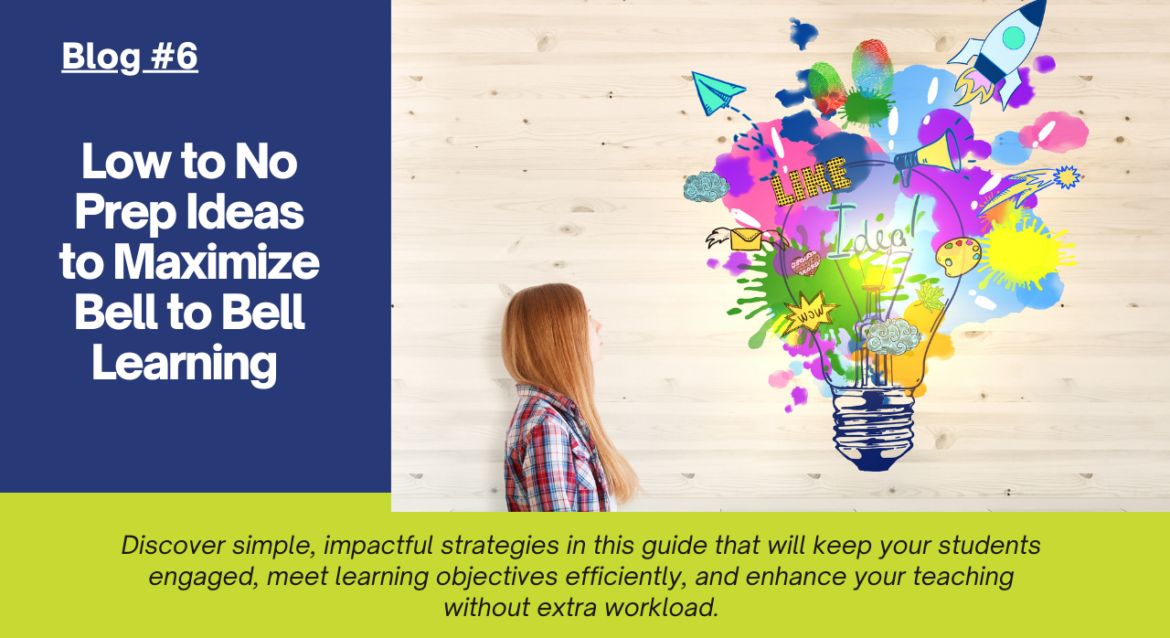
Discover simple, impactful strategies in this guide that will keep your students engaged, meet learning objectives efficiently, and enhance your teaching without extra workload.
What: Engaging Students to Maximize Learning Time
Bell-to-bell teaching and learning involves utilizing every minute of class time effectively, including the crucial last 10 to 15 minutes. This approach is designed to maximize time for reinforcing learning objectives such as essential questions, learning targets, and success criteria, thereby aiding students in meeting or surpassing grade-level standards. It keeps students actively engaged in their learning process and facilitates peer interaction. Implementing bell to bell learning doesn’t have to mean additional work for teachers. Simple, practical activities can be seamlessly integrated into the classroom routine, providing beneficial learning experiences without requiring extensive extra preparation. These activities can also offer students a welcome change of pace following intense lessons or assessments. This blog offers simple straightforward ideas to enrich classroom learning experiences, designed to be easily adoptable by teachers, school leaders, and educational coaches.
Benefit for Teachers
Imagine you’re a teacher, and during a recent observation, your principal noticed that in the last 10 minutes of class, students were disengaged, on their phones, and not participating in any structured activity. The feedback was to maximize learning from bell to bell. You feel overwhelmed with planning and need a few minutes at the end of the class period to check in with students and get ready for your next class. This guide provides practical, easy-to-implement strategies for bell to bell learning. Low prep and can be high impact and even run by students.
Benefit for Leaders
As a principal aiming to encourage bell-to-bell teaching and learning without overwhelming your teachers, this guide offers concise, effective strategies. It’s a resource you can provide to teachers, helping them to see the value in maximizing every minute of class time. The key is to present these strategies as enhancements to their current practices, not as additional burdens.
Benefit for Coaches
As a coach, you might use this guide to support teachers in increasing teaching and learning throughout each class period. The focus should be on strategies that are impactful yet require minimal extra preparation. This approach ensures that teachers feel supported and not overwhelmed by the prospect of implementing new techniques.
Why: The Importance of Utilizing this Time
- Reinforcement: These activities allow for the reinforcement of key concepts, ensuring that students leave the classroom with a solid grasp of the material covered during the lesson.
- Assessment: Formative assessment through exit tickets and peer reviews helps teachers gauge student comprehension, enabling them to tailor future instruction accordingly.
- Collaboration: Activities like peer teaching and discussion reflection encourage collaboration and the exchange of ideas among students, enhancing their learning experience and interaction with their peers.
- Critical Thinking: Many of these activities promote critical thinking as students apply what they’ve learned, engage in problem-solving, and participate in reflective discussions.
- Ownership: These practices empower students to take ownership of their learning, encouraging them to actively process and articulate what they’ve learned.
How: Implementing Effective Practices
- Incorporate Gradually: Introduce these activities gradually into your classroom routine to allow both teachers and students to become comfortable with them.
- Variety: Utilize a variety of activities such as summarization, exit tickets, peer review, and more to keep engagement high and cater to different interests of students.
- Student Leadership: Encourage students to take the lead in facilitating some of these activities, promoting a sense of responsibility and ownership and allowing the teacher time to prep for the next class and check in with individual students as needed.
- Routine: Establishing a routine for these activities ensures that they become an integral part of the learning process.
- Feedback: Continuously gather feedback from students on the effectiveness of these activities and make adjustments as needed.
Low and No Prep Ideas
- Quick Summarization Activity: Have students summarize the main points or key takeaways from the lesson in a concise paragraph or a set number of bullet points. This reinforces their understanding of the learning objectives and encourages them to prioritize information.
- Exit Tickets: Provide students with a few questions related to the day’s lesson. These questions can be directly connected to the learning targets or essential questions. Students can quickly answer these questions on a small piece of paper or digitally. This formative assessment helps both teachers and students gauge comprehension.
- Peer Review or Feedback: If students have been working on assignments or projects, allocate time for peer review. Students can exchange their work and provide feedback based on established success criteria or rubrics. This promotes collaboration and self-assessment.
- Discussion Reflection: Engage students in a brief class discussion reflecting on the day’s learning. Pose open-ended questions related to the essential questions or key concepts, and encourage students to share their thoughts and insights. This helps solidify their understanding and allows for peer learning.
- Application of Learning: Have students apply what they’ve learned to a real-life scenario or problem. This could involve a short case study, scenario analysis, or a practical exercise that connects the lesson’s content to the real world. Have students come up with these ideas and use throughout a unit.
- Quick Quiz or Poll: Use a digital platform or simple paper-and-pencil quizzes or polls to assess students’ understanding of the material. This can be done through multiple-choice questions or short-answer responses. Instant feedback can be provided to students. Have students generate the questions.
- Peer Teaching: Assign students to small groups and have each group teach a specific aspect of the day’s lesson to their peers. This promotes active engagement and reinforces their understanding as they explain concepts to others. Have students identify the need for reteaching based on the learning target and success criteria.
- Journaling or Reflection: Ask students to write a brief journal entry reflecting on what they’ve learned, any questions or uncertainties they have, and how the lesson connects to their lives or the world around them. This encourages metacognition and deeper understanding. Be sure to follow up on these the next day so students don’t feel it was just busy work.
- Goal Setting: Have students set personal learning goals based on the day’s objectives. These goals could be related to further exploration of the topic, improvement in specific skills, or connections to future lessons. Students can share their goals or keep them private.
- Review of Homework or Assignments: Use this time to clarify any doubts or questions related to homework or upcoming assignments. Students can ask for clarification, and teachers can provide additional guidance or resources.
- Quick Vocabulary Activity: If the lesson introduced new vocabulary, engage students in a quick vocabulary-building exercise. This could involve creating flashcards, matching definitions to terms, or using the vocabulary in context sentences. Provide a pre test on unit vocabulary and use the words students need repetition with the most.
- Visual Representation: Ask students to create a visual representation (e.g., a concept map, diagram, or sketch) of the main ideas or concepts covered in the lesson. Visuals can reinforce learning and provide a different perspective. Hang the visuals up. This could be an activity over several end of class periods.
- Peer Sharing: Allow students to share their work, insights, or responses with a partner or in small groups. This peer sharing fosters discussion and reinforces the lesson’s content. This is especially effective if students have a portfolio or notebook that contains ongoing notes, essays, etc.
- Goal Reflection: If students set goals at the beginning of the lesson, have them reflect on whether they met their goals by the end of the class. This promotes self-awareness and self-assessment. Using learning targets and success criteria would be especially helpful.
- Quick Brainstorming Session: Pose a question or problem related to the lesson and conduct a brief brainstorming session. Encourage students to generate ideas, solutions, or perspectives. This can be a creative and engaging way to conclude the class.
- Vocabulary Bingo: Create bingo cards with vocabulary words or key concepts from the lesson and unit. Read out definitions or descriptions, and students mark the corresponding terms on their cards. The first to complete a row or column calls out “Bingo!” This game reinforces vocabulary retention. Once taught, students can lead this easily.
- Word Scramble: Provide students with a list of vocabulary words or important terms from the lesson that are scrambled or jumbled. Students must unscramble the words within a time limit. This game reinforces spelling and comprehension.
- Vocabulary Pictionary: Assign each student a vocabulary word from the lesson. Without using words, they must draw an image that represents the word. Their peers then guess the word based on the drawing. This game enhances visual learning and understanding of terms.
- Jeopardy Review: Divide the class into teams and set up a Jeopardy-style quiz with categories related to the learning objectives. Students take turns selecting questions and answering them. This game reinforces content knowledge and critical thinking. This could be played over multiple end of class periods.
- Quizlet Live: Use the Quizlet Live platform to create a competitive quiz with questions related to the lesson. Students are divided into teams and must collaborate to answer questions correctly. It’s an engaging way to reinforce knowledge.
- Kahoot!: Create a Kahoot! quiz with questions related to the day’s content. Students can join the game using their smartphones or devices. Kahoot! adds an element of competition and excitement to the review process.
- Vocabulary Charades: Similar to Pictionary, but in this game, students act out the vocabulary word without using any spoken words. Their peers try to guess the word based on their actions. It promotes creativity and understanding of terms.
- Matching Game: Create pairs of cards, each with a vocabulary word and its corresponding definition or image. Mix up the cards, and students take turns flipping them to find matches. This game reinforces word-to-definition associations.
- 20 Questions: Choose a vocabulary word or concept from the lesson and have students ask yes-or-no questions to guess what it is. They have a limited number of questions (e.g., 20) to figure it out. This game encourages critical thinking and deductive reasoning. This can easily be lead by students after the teacher teaches it.
- Buzzer Round: Use buzzers or noise-making objects and read out definitions or descriptions of vocabulary words. The first student to buzz in and correctly identify the word earns a point for their team.
Checkout Connect Strategies. An additional free resource for engaging students with you, with their peers, and with the content. It comes from STRIVE’s L.I.T.E.R.A.C.Y. Book for all content area teachers.
We must take care of the teachers, leaders, and coaches that take care of our children
-Debbie
Our aim is simple: to provide as many helpful resources as possible to teachers, leaders, and coaches. Every comment you make and every share helps us achieve this goal.
Leave a Comment: Your thoughts and experiences are valuable to us and other readers. Join the conversation and help us all learn more!
Share with Others: Know other teachers who could benefit from our resources? Spread the word and help us reach more educators



4 Comments
Jayme Bennington
These are some really great, low prep ideas! I particularly appreciate the concept that bell-to-bell learning (rather than bell-to-bell instruction) puts the emphasis on students engaging in learning for the whole class without requiring additional planning for teachers. I will definitely share this blog post with the secondary teachers I coach.
Debbie
Thanks Jayme!
Jonna Schwartz
As a classroom teacher and an instructional coach, the information in this blog is invaluable—establishing the why behind maximizing bell-to-bell instruction/lesson closure is an important reminder for me, along with the broad categories explaining how to maximize instructional time at the end of a lesson.
The list specific activities is a great “pick one and go” resource.
I especially appreciate that most of those don’t need to be formally graded and can be assessed quickly by teachers!
Debbie
Thanks Jayme! I hope people find them useful.